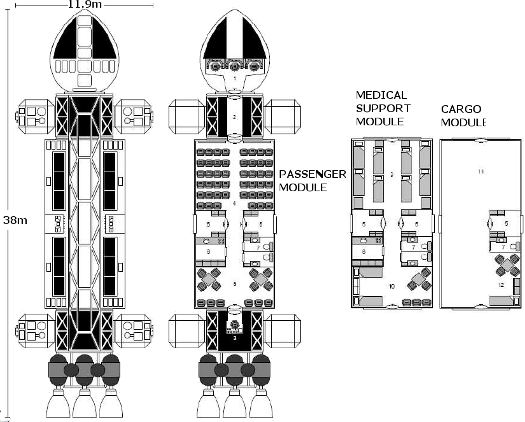Eagle Transporter
By Scott Iles
The Eagle Transporter is a size class two system ship.
It has rudimentary astrogation equipment and basic
flight controls. Its unique feature is the detachable
payload module, which can be swapped out quickly to
convert the ship for various missions. Three of the
most common modules are detailed below.The Eagle is not equipped to enter the dense
atmosphere of a Class-M planet, or to land on anything
with more than a .1g gravitational field. It is used to
transfer personnel and material between stations and
trips between nearby planets.
1. COCKPIT MODULE - This is the control center of the
ship. There are seats and consoles for the pilot, co-pilot
and communications/navigator. Note that the center
position (Comm./Nav.) does not have a forward
viewport.
2. ACCESSWAY - This access passage connects the
cockpit with the module in the center. The main life
support systems can be accessed in this area. There
are pressure doors at either in in the event of
atmosphere loss.
3. ENGINEERING - The monitoring equipment for the
chemical drives is in this small area. Only two humansized
beings (or 1 Vrusk) can fit in this compartment.
PASSENGER MODULE
4. PASSENGER COMPARTMENT - Forty-six comfortable
seats allow the passengers to relax as much as possible
on flights between bases. Video panels on the forward
bulkhead display entertainment and flight status
information.
5. AIRLOCK - Most modules have two airlocks, one on
either side. Storage lockers in each airlock have four
standard spacesuits. It takes one minute for the airlock
to cycle either way (pressurized to vacuum, or vacuum
to pressurized).
6. GALLEY - This small compartment contains
foodstuffs and prep equipment. Normally, only the food
for the next meal is stored here, with the rest of the
supplies kept in underdeck storage compartments.
7. HEAD - These are small, but fully equipped
refreshment stations. A retractable curtain converts the
outboard half of the space into a zero-g shower.
MEDICAL SUPPORT MODULE
9. PATIENT WARD - Eight double bunks provide bedspace
for up to sixteen patients. This module is used
for responding to disasters and transporting patients to
more advanced care facilities.
10. LOUNGE - This is similar to the lounge in the
passenger module, but replaces one of the tables with
two double bunks for the medical staff to use or
additional patient space.
CARGO TRANSPORT MODULE
8. LOUNGE -This area allows the passengers and crew
to get up and move around during flights.
Entertainment displays and tables allow for
socialization and recreation.
11. CARGO BAY - This module opens up as much space
as possible for the transport of cargo. Note that this
module only has one airlock, on the starboard side. The
hatch on the port side is used for loading in a
pressurized environment.
12. CREW LOUNGE - This small area allows the crew to
rest during long flights. An Eagle with this module
normally operates with only two crewmen.

| Hull Size: | 2 |
| Engines: | 1 Chemical (four thruster nozzles) |
Life Support Capacity: | 6 (Cockpit Pod), Module capacity varies |
| Computer: | Level 2 (17 function points) |
| Programs: | Drive 1; Alarm 1; Damage Control 1; Astrogation 2; Information Storage 2 |
| Equipment: | Videocom Radio, Radar |
51